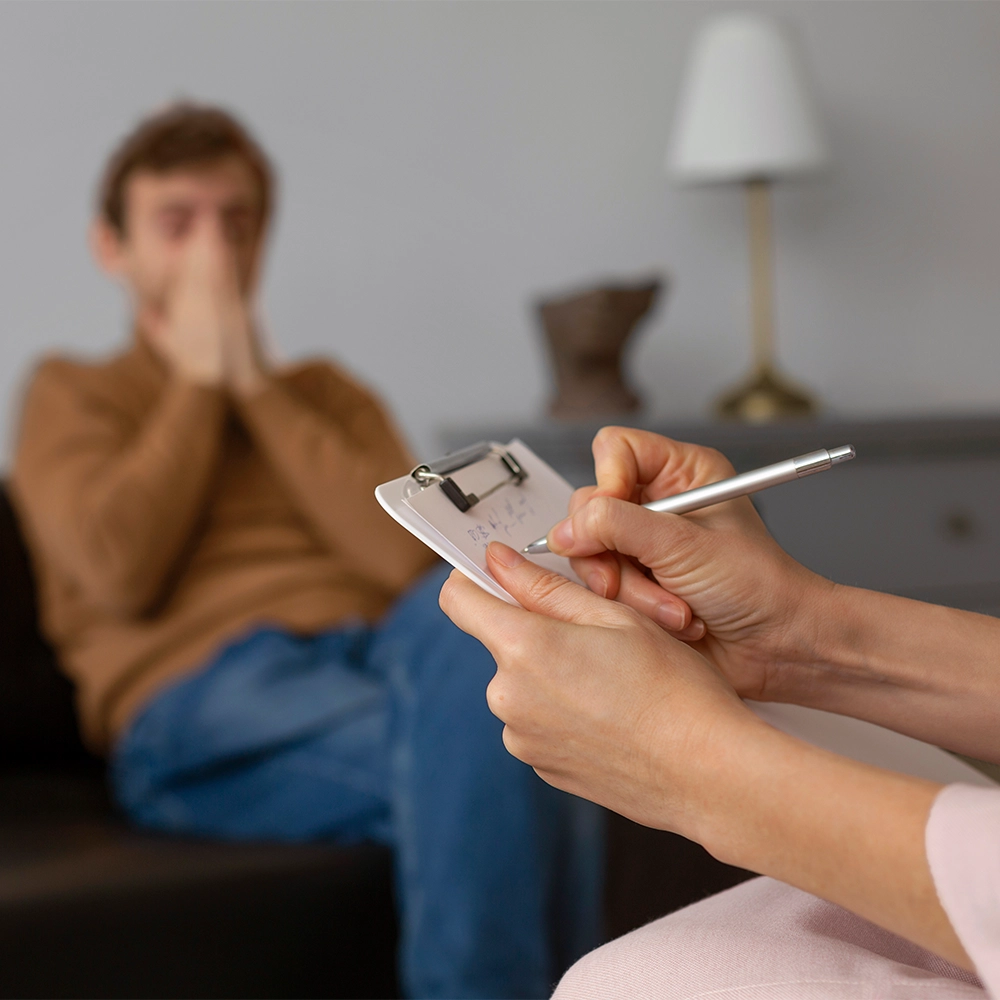- Mumbai, New Delhi, Bangalore
- (+91) 81518 30000
- WhatsApp Now
- contact@vedawellnessworld.com
Body Dysmorphic Disorder (BDD) is a mental health condition in which a patient is obsessed and fixated upon perceived non-existent or minor flaws in physical appearance. These flaws are entirely unnoticeable to others. Despite their insignificance, these perceived imperfections can disrupt a person’s self-esteem and daily life, relationships, and emotional well-being. The good news is that BDD is a curable condition with the right medical support, therapies, and understanding from loved ones.
In this blog, we’ll explore:
Read on to gain a deeper understanding of this condition and the steps to help yourself or someone you care about begin their journey to recovery.
Body Dysmorphic Disorder (BDD) is a psychological disorder characterised by an obsessive focus on supposed flaws in one’s appearance that are either minor or non-existent. Despite their insignificance, a patient suffering from BDD who is preoccupied with these flaws experience intense distress and cannot function properly in daily life.
People suffering from BDD often become fixated on specific body parts, such as the nose, skin, hairline, chest, or other areas they feel are flawed and feel dissatisfied. This obsessive focus can lead to low self-esteem, chronic stress, social withdrawal, and difficulty maintaining normal routines, as the condition takes a toll on both emotional and psychological well-being.

A person can feel underconfident about any body part in general, therefore, body dysmorphic disorder can manifest in multiple ways. While some individuals may experience a generalized dissatisfaction with their appearance, others may exhibit more specific subtypes of BDD. Two notable subtypes include:
Muscle Dysmorphia
A patient suffering from muscle dysmorphia might feel that his or her body is not muscular or big enough even when it may be well-developed by normal standards.
This condition is sometimes referred to as “reverse anorexia” or “bigorexia.”
Individuals with this disorder may:
This subtype primarily affects men but can impact anyone and may lead to serious emotional and physical health issues.
Proxy Body Dysmorphia
A patient suffering from body dysmorphic disorder becomes obsessed with someone else’s appearance such as a partner, friend, or family member.
This obsessive concern can cause significant distress and dysfunction in relationships. Individuals may:
Though less common, this form of BDD can be particularly challenging and often requires professional intervention.

Body Dysmorphic Disorder does not have a single, definitive cause. Instead, it typically arises from a combination of psychological, environmental, and genetic factors that influence how individuals perceive themselves. Mental health experts have identified certain factors that influence a person’s self-perception:


Excessive preoccupation with a conceived flaw can cause distress. Here are the most common body dysmorphic disorder symptoms and signs noticed among patients:
The first step of body dysmorphic disorder treatment is diagnosis, which includes conversing with the patient. Here are a few factors considered before a body dysmorphic disorder treatment process starts:
Body dysmorphic disorder treatment is an extensive procedure that begins with getting a proper diagnosis, which starts with open conversations with the patient.
Before beginning treatment, professionals look at a few key areas and various therapies are recommended to treat the condition, such as:
Cognitive Behavioral Therapy (CBT): A widely used and effective approach that includes:
Myth 1: BDD is just another type of eating disorder.
Fact: Body Dysmorphic Disorder is a psychiatric problem focused on perceived physical flaws and not directly related to eating habits.
Myth 2: BDD only affects people who are vain.
Fact: Body Dysmorphic Disorder stems from low self-esteem and not vanity. People with BDD often feel insecure, anxious and under-confident.
Myth 3: People grow out of BDD as they get older.
Fact: Anybody suffering from BDD needs to see a mental health expert immediately, as the condition can worsen with age, leading to other problems such as severe anxiety, depression, or social isolation.
Myth 4: Cosmetic procedures can cure BDD.
Fact: Surgery doesn’t fix the root cause of BDD. Even after cosmetic changes, individuals often remain unhappy. Only therapy can instil the lost self-confidence in the person so that he or she feels complete and normal.
Myth 5: Body Dysmorphic Disorder mostly affects women.
Fact: No. BDD can affect anyone, regardless of gender. Men are as vulnerable (particularly to subtypes like muscle dysmorphia) as women because anyone can be afflicted with a psychological problem at any age.


Body Dysmorphic Disorder (BDD) can deeply affect an individual’s self-confidence, but with the right support and treatment, recovery is absolutely possible for a patient. In some severe cases, BDD can lead to suicidal thoughts, which is why early intervention is crucial and should be taken very seriously. Emotional distress and social withdrawal are common, so it’s important for family and friends to offer kindness, patience, and encouragement to help the person feel supported and not alone.
If you know someone who is suffering from BDD, here are a few ways to show support for the person to feel better:
In-Patient Treatment Programs: For people severely suffering from this psychological problem, Veda Rehabilitation Centre offers residential programs. Patients stay under constant supervision and a healthy diet to recover faster.
Customised Treatment Plans: Treatment provided at Veda Rehab Centre is tailored to a patient’s health condition. A one-size-fits-all approach is not followed by any therapist at this centre. The staff ensure that the treatment suits the patient so that he or she can recover completely.
Relapse Prevention Process: Relapse prevention is included in the treatment. Counsellors arrange sessions with the patient once the therapies are over to watch their behaviour. They keep a check on their mood swings and also scrutinise their habits.
Latest Facilities: Latest technological tools, voluntary and discreet treatment, 24/7 nursing staff, and therapy rooms are some of the facilities that are provided here. Patients are under constant CCTV supervision and are provided all nutritious and freshly cooked meals through day.
According to reports, BDD is more prevalent among people than anorexia and bulimia. As of 2024, body dysmorphia affected 1-2% of the entire Indian population. What is more serious is that it mostly affects people between the ages of 15 and 17.